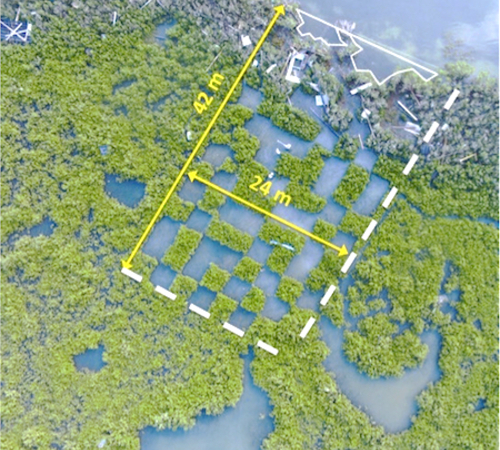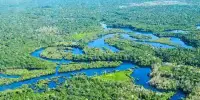An international study of the effects of 26 tropical cyclones on land reveals trade-offs between ecosystem resistance and resilience. The findings can help managers plan for the impacts of climate change on coastal ecosystems and economies.
An international research team addresses a centuries-old question in a new study on the ecological impacts of hurricanes: when faced with a storm, is it better to be resistant like oak or resilient like a willow?
The team’s findings, published in the journal Science Advances, can help managers plan for climate change and a growing coastal population threatened by more intense tropical storms that track farther into temperate latitudes. The findings also offer a framework for guiding management decisions in the face of other disturbances, such as nutrient pollution or wildfires.
The study’s lead author, Dr. Christopher Patrick of William & Mary’s Virginia Institute of Marine Science, says “We found that coastal ecosystems display consistent tradeoffs between resistance and resilience to tropical cyclones. Our findings emphasize that managing for increased resistance may result in decreased resilience, and vice versa. That knowledge is key for coastal decision making, particularly as climate change alters the risk profile with stronger, more frequent mid-latitude storms.”
Patrick uses his experience as the director of VIMS’s Seagrass Monitoring and Restoration Program to demonstrate these management trade-offs. “In the Chesapeake Bay, eelgrass tends to be more stable over time than widgeon grass, but it takes longer to recover from disturbances like hurricanes,” he says. This trade-off, which would also apply to diebacks caused by poor water quality or heat stress, is an important factor for coastal managers to consider when deciding which species of seagrass to restore.”
Our research found a consistent pattern of trade-offs between resistance and resilience across categories. These patterns, according to the authors, are most likely the result of evolutionary adaptation and conform to ecological-disturbance theories, implying that consistent rules govern ecosystem susceptibility to tropical cyclones.
Dr. Christopher Patrick
A repeated pattern of resistance/resilience trade-offs
All told, the researchers used pre- and post-storm monitoring surveys to analyze patterns of ecosystem resistance and resilience from 26 Northern Hemisphere storms. These made landfall between 1985 and 2018 in states from Texas to North Carolina, as well as in Puerto Rico and Taiwan.
The researchers assessed storm characteristics and impacts by measuring total rainfall, maximum rainfall rate, and windspeed. They then divided their study areas into four ecosystems (freshwater, saltwater, wetland, and terrestrial) and five “response categories,” yielding a total of 4,138 time series. The response categories documented not only post-storm changes in the distribution and abundance of living things – populations of mobile animals like fishes, sedentary animals like oysters, and vascular plants like mangroves – but also changes in the ecosystem’s biogeochemistry (e.g., salinity, nitrogen) and hydrography (e.g., depth and shoreline position).
“Our research found a consistent pattern of trade-offs between resistance and resilience across categories,” Patrick says. These patterns, according to the authors, are most likely the result of evolutionary adaptation and conform to ecological-disturbance theories, implying that consistent rules govern ecosystem susceptibility to tropical cyclones.
One example given by the researchers is the fate of Jamaican forests after Hurricane Gilbert. When this powerful category 5 storm hit the island in 1988, it wiped out stout, normally resistant species like the Jamaican treefern, allowing myrtles and other weedy, shrubby species to colonize the now-open gaps in the canopy.


Knowledge to guide effective strategies
The findings of the team indicate that managers seeking to improve both resistance and resilience in coastal ecosystems may face an impossible task. Their findings, on the other hand, provide valuable guidance for selecting the single most effective management strategy for a specific location.
“If you can’t manage both resistance and resilience,” Patrick wonders, “which should you prioritize?” The answer is determined by both project objectives and the expected intensity and frequency of disturbance events.”
Under a relatively static, predictable climate, resistance would generally be the better restoration strategy in areas with infrequent disturbance. “Under this scenario,” says Patrick, “managers would ideally select resistance as the main feature of their restoration strategy, so that the function you’re interested in — slowing coastal erosion, preserving water quality — doesn’t waver when it gets knocked by a big disturbance.” Managers might, for instance, choose to plant mangroves rather than marsh grasses to protect against coastal erosion, as mangroves are more resistant to large storm waves.
When and where conditions change, however, resilience may emerge as a better option. “If disturbances are going to be more severe, more frequent, or both — outstripping a particular species’ potential resistance,” Patrick says, “managers might focus on resilience so that recovery time following disturbances is quick.”
“If it takes 25 years for one tree species to grow large enough to resist the average hurricane, but hurricanes now start impacting an area every 20 years,” he adds, “trying to cultivate it is probably a waste of effort.” “The most effective restoration strategy is determined by the frequency and intensity of disturbance events now and in the future.”
Future Directions
As one of the first comprehensive studies of the ecological impacts of tropical cyclones, the team’s analysis raises as many questions as it answers, and points to several important areas for future research by the group, formally known as the Hurricane Ecosystem Response Synthesis Network, or HERS.
Future research areas, guided by a HERS steering committee, include investigations into how species traits such as reproductive potential, dispersal mode and distance, and physiological tolerance may explain patterns of resistance and resilience at the population level; or how an ecosystem’s long-term or recent environmental history may influence its response to subsequent disturbances. Scientists believe that Hurricane Agnes in 1972 was especially damaging to seagrasses in the Chesapeake Bay because it arrived in June, before most species had gone to seed. Managers could better evaluate an ecosystem’s likely sensitivity to a forecast disruption if they had a better understanding of previous conditions.
















